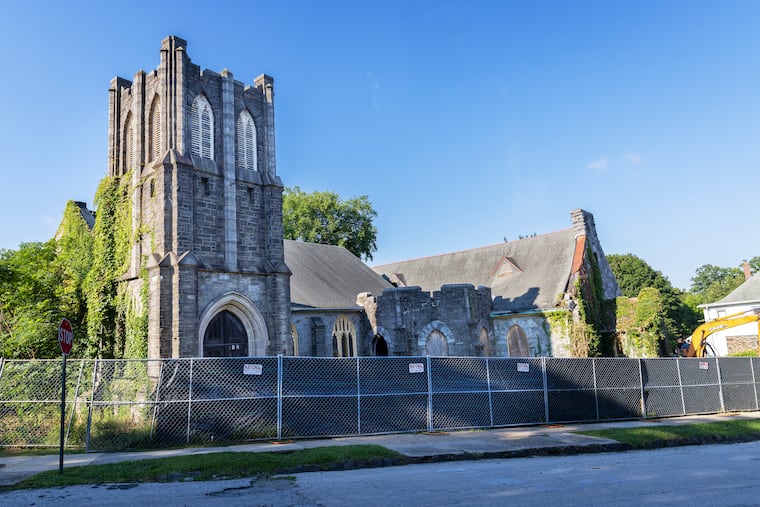Does Narberth have a rat problem — and is it about to get a lot worse?
A vacant church on Narberth's south side may or may not be housing a "rat city."

In certain parts of Narberth, beneath the shade trees and cushy hammocks, the showy blossoms and well-tended hedges, loathsome vermin now skitter and romp.
Time was, residents say, you would rarely, if ever, see rats in this desired Main Line enclave, where some homes list for well over $1 million. But lately, a few scavenging predators have been running riot.
“I saw one the other night, scampering across the street,” said John Munroe, 21, a rising political science senior at Chestnut Hill College, and a resident of the borough’s south side. “Nobody ever talked about rats my whole life living here.
“But now it’s raw and recent.”
Ask neighbors the source, and they all point to one place: the long-empty Baptist Church of the Evangel on Elmwood Avenue, a 131-year-old gray stone edifice, decaying and forsaken, sitting across from the Narberth SEPTA station and ringed by a fence with a “Private Property No Trespassing” sign.
The thing is, no one can say for certain whether the church is the rat command center — although many people who are currently complaining about the germy creatures live near the building.
“My boyfriend saw one in our parking lot,” said Sabrina Johnson, 41, a first-grade teacher at a Quaker school on the Main Line. Her home lies within a few yards of the church. “My daughter saw a rat in the driveway across the street. And one of my neighbors had a rat in their kitchen, up on the second floor. The second floor!
“It’s unnerving — just nothing I want to see. I grew up in West Philly, where my family saw its share of rats. But out here, living with people who have financial stability, rats are something you usually don’t have to worry about.”
A homeowner whose land abuts the church and who didn’t want to be identified because she’s embarrassed that rats scurry across her property, said that she’d contacted a private exterminator who couldn’t do an inspection but guessed there’s an entire “rat city” clustered inside the former house of worship.
Could he be right?
“It’s a myth that all abandoned buildings house rats,” said Dion Lerman, a rodent, bedbug, and roach expert with the Pennsylvania Integrated Pest Management Program at the Penn State Extension Philadelphia County office in the Navy Yard.
But if rats have access to food (often garbage, birds, and insects) as well as fresh water, they could very well populate a vacated structure, even though they prefer outdoor burrows, Lerman explained. (As a special warning to suburban bird lovers with backyards, by the way, Lerman added that bird feeders often attract rats, who love foraging for fallen seeds.)
As if anyone needed to understand that rats are foul critters to be avoided, Lerman said they can transmit “a couple dozen” diseases, including “salmonella, E. coli infections, and other things you don’t want to know about.”
Beyond that, they’re apparently remorseless arsonists: Rodents, including rats, are responsible for 20% of fires of undetermined origin in the United States because they chew through electrical wires (the word “rodent” is Latin for to gnaw), believing they’re stalks yielding yummy seeds, Lerman said.
Though Munroe and others said they’d never seen a rat in Narberth until now, others in town have reported them — at least sporadically — going back to at least 2016, according to Kevin Walsh, building code enforcement officer for the borough.
Still, if the church has been vacant for seven years, as Narberth officials say, why have people been detecting a rat surge in recent weeks?
Several neighbors reported seeing a piece of construction equipment on church grounds either digging or removing brush recently, which they believe has dislodged rats and caused them to flood the neighborhood.
This prompted Johnson to convey the fear that she and her Narberth neighbors have been expressing in crescendo-ing voices lately:
What happens when the church gets demolished, an event scheduled for the coming weeks?
“They all,” Johnson said, pausing for emphasis, “all will be coming out.”
Rat tsunamis are, one would think, unsavory occurrences. How real is the possibility?
“Oh, if you don’t control a population before you destroy a structure they’re living in, they will scatter,” Lerman said.
But Walsh offered a reassuring thought: “Before demolition, I’ll do a walk-through and make sure proper extermination facilities are in place.”
Will that be enough? distressed homeowners ask.
It’s the responsibility of the site owner, Jason Gordon, listed as a Bala Cynwyd forensic accountant, to clear out any rodents before he demolishes the church, Walsh said.
Gordon, who did not respond to requests for comment, is a well-known figure in the borough.
Originally, he proposed to turn part of the church property into a site for his business, and said he’d require several parking places on the street.
That created an uproar in Narberth, where parking spaces are at a premium, and where residents object to any business structure being built in South Narberth.
“We’re concerned about creeping commercial activity,” said retired homeowner Rosemary McDonough, 68. “The unwritten rule here is that the south side of town must remain completely residential.”
Reading the vibe, Gordon withdrew the site plan, which now calls for around 20 residential units, Walsh said.
But before they’re built, whatever wildlife that may or may not exist in and around the old church will have to be addressed.
“I hope the borough gives us a warning to keep our doors and windows shut when the building comes down,” Johnson said.
“Seeing rats — it’s not the best sight over here.”
Staff writer Ryan W. Briggs contributed to this article.